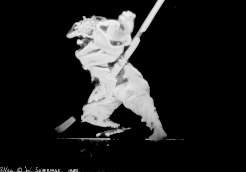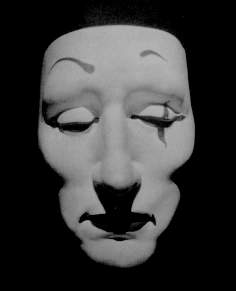This article was published in
LEONARDO, Vol. 28, No. 4, pp. 273-280,1995
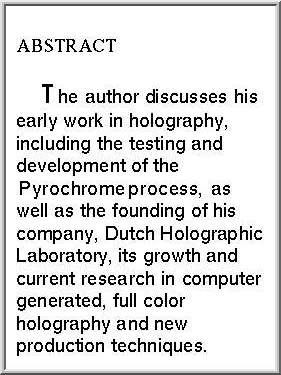
GENERAL ARTICLE
Dutch Holographic Laboratory
Walter Spierings
with Ana Barreto
TURNING HOLLAND INTO “"HOLOLAND”"
I could not have envisioned the development of DHL back in the late 1970s. I was introduced to holography by sheer coincidence. After I finished my studies in chemical analysis in 1979, a friend helped me get my first job: hammering nails in the wall to hang Holland's first holography show, "Net Echt" (Almost Real), exhibited in celebration of the 100th anniversary of the invention of the lightbulb. Walls were built and halogen lights constructed under the guidance of exhibition guru jim Finlay of New York.
Eindhoven has long been a center for technical innovation in the Netherlands. It is known as the "City of Light" because it is home to the Philips company, inventor of the compactdisc player and the world's largest manufacturer of light bulbs. Large research laboratories, both at Philips and the neighboring university centers, have created an atmosphere and infrastructure of creative technical expertise.
During the Net Echt exhibition, my curiosity about holography's revolutionary potential was stimulated and continues to this day. After working on several other major shows in Holland set up by Finlay, I was prompted to take a short holography course offered by the exhibition organizers, Ideecentrum, at the University of Technology in Eindhoven. With theoretical guidance from the teachers of the course, I constructed a simple setup for single-beam reflection holograms and, as luck would have it, my first shot turned out right immediately. The teachers at the university's electronics department were impressed, as they had only read about reflection holograms. Though easy to set up, these holograms were considered harder to make than laser transmission holograms because they were less familiar, were extremely sensitive to vibration and required delicate chemical processing. As a result, I ended up teaching the last day of the course.
Interest rose quickly in the department. Though my student days were officially over, the university was so enthusiastic about my success with holography that Hans Butterweck, one of the instructors, gave me the opportunity to develop a holography lab at the university. In exchange, I acted as an unofficial researcher and assisted graduate students with their projects. A new room was allocated for a holography laboratory on the fifth floor between two elevator shafts, a very difficult location for the vibration isolation conditions necessary for holography. To compensate, I devised a system for supporting the holographic table with styrofoam legs and inner tubes.
BUILDING UP FROM HUMBLE BEGINNINGS
I did not have money for holographic film or plates, so a friend lent me a box of 10 8xl0-in plates. Once a plate was out of the box, I could enter or leave the shed only at night to avoid fogging the plate. The plateholder was a piece of compressed wood with three clothespins glued into place. |
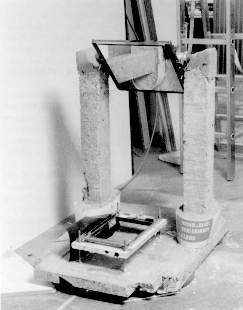 Fig. 2. This shooting surface and overhead mirror rig, created from an old stone kitchen table and a broken concrete fence pole, was used in the author's homemade holography lab in a shed behind his house in 1980. |
I would develop plates in a top tray, wash in a bucket on the floor and bleach in another tray under the development shelf. There was no running water. After six trials, my seventh plate came out great. The image, a Pierrot mask, was framed and hung in a gallery run by Foundation Ideecentrum in Eindhoven.
DEVELOPING A HOLOGRAPHIC DEVELOPER
About a week later, Ruud van Renesse of the Dutch National Physics Laboratory (TNO) came by the gallery and was struck by the red color of the Pierrot hologram. He was more intrigued after finding out it was shot by a Dutchman. He waited for 2 hours while the gallery tracked me down and I bicycled there. Surprised as I was to be asked for by a prominent scientist, it seemed that van Renesse was just as surprised to see a 23year-old come in. At the counter of the shop, he scribbled an idea on a scrap, outlining a formula for a holographic developer that he thought would also be able to produce red holograms. In 1980, red holograms were rare things. His idea was to use pyrogallol as the developing agent, followed by a solution that bleaches and removes dark developed silver crystals in the holographic emulsion, leaving undeveloped emulsion as a brighter carrier of the holographic recording.
I brought him to the lab in the shed on the back of my bicycle to see where the Pierrot hologram had been shot. Van Renesse was astonished that the combination of old junk in the shed could produce the hologram he had seen. We then went to the university lab, which, even under construction, was a more familiar environment for a research scientist.
One evening a couple of months later, in October 1980, I tried out the process in the shed. After drying the plate, the hologram was not red; in fact, it had turned green. The next day I telephoned van Renesse, who was not able to explain how this result was possible. We made an appointment, and I went over to Delft to visit him at the National Physics Laboratory. I showed him the results, and we still could not figure out what was going on. After leaving van Renesse, I was waiting for the bus back to the train station, and I thought of the solution. I realized that the by-product of pyrogallol's reaction with silver hardens the gelatin, but when excess sulphite is present in the solution, the by-product reacts more quickly with sulphite than with gelatin. Then, when the reversal bleach dissolves the developed silver into solution, the emulsion layer collapses, resulting in a shorter wavelength reflection hologram. Of course, without sulphite, the gelatin will harden and not collapse, resulting in a hologram of about the same color as the original recording wavelength.
The next day, I phoned van Renesse, who had come up with a similar analysis. I immediately saw the possibility of color control through varying the sulphite concentration in the developer. My training in chemical analysis was a boon to my understanding of these processes, which simplified testing procedures considerably.
Although the process had been published in scientific literature much earlier by Kurtz and Lambert [1], a number of people (including van Renesse) encouraged me to write about the process, which I dubbed the "Pyrochrome" process, in Holosphere [2]. After the article came out in August 1981, the popularity of the process increased rapidly due to a variety of reasons. Pyrochrome offers good results for both reflection and transmission holograms, has a wide range of workable concentrations, and allows various options for color control and low toxicity. Though catechol based developers have since found a place in tight color-control processing, the Pyrochrome process continues to be a favorite for testing and educational purposes because of its flexibility and reliability.
GOING INTERNATIONAL
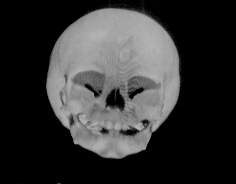
Fig. 3. Skull, limited edition hologram (50 copies), 8x10 in, 1982. This is a hologram of a 70 year old skull of a 10-month-old child.
Fig. 4. Samurai, limited edition hologram (50 copies), 8x10 inch, 1982. The android-like samurai in the hologram appears to kick into the viewer's space.
Fig. 5. Pierrot, limited edition hologram (50 copies), 8 x10 inch, 1983. |
I started my first limited edition holograms in 1982 with Skull (Fig. 3) and Samurai (Fig. 4) and continued, in 1983, with The Kiss and a technical improvement of the Pierrot hologram that van Renesse saw (Fig. 5). In 1983, I also started my work with broadband development processes, which operated in the Russian regime of colloidal development. Several series of images were processed this way: The Kiss, Triangle, and The Link. The process itself was unique. It could produce achromatic images with only one exposure and one processing step or, like The Link, would produce three distinct colors in one exposure step (red, yellow and green). The work resulted in the publication of my results in 1985 at the Lake Forest conference [3]. |
More custom orders were coming in, which I filled in the university's lab during off-hours, and the university electronics department decided to put a telephone in the lab because I was receiving many long distance calls. I did custom work for clients in Germany, Switzerland, England, Belgium and France, all through the holography network. Although I continued research for 4 years at the Eindhoven University of Technology, and the university was very supportive, there was no assurance that I could stay there forever, especially since more and more students were becoming interested in holography and research projects were being planned.
Space at the university was becoming precious, and I realized I would soon need more space to expand. Meanwhile, my business was growing and I had no business structure at that time. After asking around, I was advised by a notary to apply to an institution for help. I was accepted to the Project for Industrial Innovation (PII) in November 1982. This was a project of the Dutch ministry of Economic affairs intended to help small high tech firms get started or else at least learn why they failed.
STARTING DHL
I received free management advice from the Dutch government for a year and a half after I started DHL; this was the only assistance the company received. (The financing of my earliest holographic work actually started with the loan of the box of 8x10 inch plates in the summer of 1980; all profits since then have been reinvested in the growth of my business.)
PII managed to talk me into setting up my own facility. Through the city housing department, I found space for rent at what had been the Dutch headquarters for Spectra Physics lasers, located facing a canal. On I December 1983, a lease contract was signed, DHL, was registered at the Chamber of Commerce, and a bank account was opened in DHL's name-all on the same day. The next morning I went to check out the new building and make renovation plans.
|
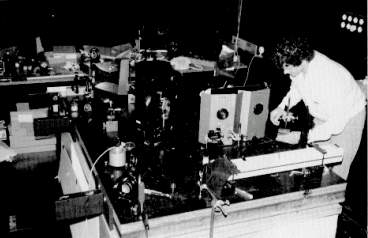 Fig. 6. Optical table made of concrete and steel with styrofoam legs at Technical University, 1982. |
Our first job at the new lab was for Lichtblicke, the re-opening of the film museum in Frankfurt, West Germany. We recorded their logo with 11 different techniques. After we finished constructing the lab in 1984, the official opening speech of DHL was performed by A. G. Van Vijfeijken of the National Business School at Nijenrode. The early days of DHL attracted considerable media attention. The Dutch TV program "People at Work" interviewed me in October 1983 about the company and its plans, and also reported on holography. The opening of DHL was heavily documented by a national newspaper and local newspapers.
As the company grew, DHL produced more stock images. The first Microscope exploited the capability of the hologram to act as a lens. Combined with the projection of the image, this hologram invites interactivity and always causes a stir when viewers finally capture the magnified image through the eyepiece [4]. The first Microscopes were produced in 1984, with The Link, Psycho-Hands, Triangle and Brave New World following quickly. By mid 1984, the stock images made at the university had been all sold (Skull, Samurai, The Kiss and Pierrot [see Figs 3-5]) and were in collections in many European countries, japan, Australia and America.
In the spring of 1985, after much testing, we began working with our first contact copy line scanner. Because all laser energy is focused into a line and swept over the contact copy to expose the hologram to be copied, the actual exposure time per unit area is reduced to tenths of a second and takes away stability problems in the film copy process.
Just before opening DHL in late 1983, I had purchased a small-frame Spectra 165 argon laser. In 1986, I decided to move into shooting holograms on photoresist plates for mass production. It was clear to me that mass-produced embossed holograms would play a major role in broadening the accessibility of holograms, as well as in the growth of the field and the development of a potential industry. For such ambitious purposes, the small-frame argon laser was too limited. I purchased a Coherent Innova 100 (the eleventh one made), which put out 32 watts on all lines. After the initial laser problems were solved, DHL examined and studied the photoresist technology (resulting in a paper presented at the Lake Forest holography symposium in 1988 [5]). In the process of working out the initial bugs, DHL came up with a number of suggestions for how to improve laser design, which have been implemented and are in use in current laser models. Photoresist work continues to come in steadily from all over the world.
|
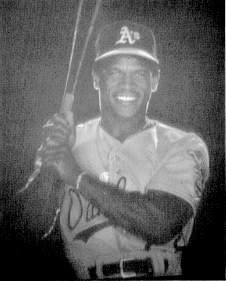 Fig 7. Ricky Henderson, full color reflection hologram, 1991. |
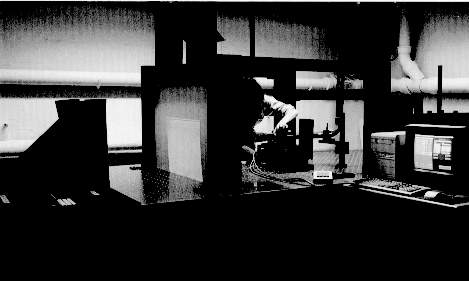 Fig. 8. Shooting holograms with a Holoprinter(R), 1992. This two-step Holoprinter was built for Kunsthochschule für Medien in Cologne, Germany. The Holoprinter is controlled by mousedriven software and converts 35-mm slides into laser-transmission master holograms. |
We also shoot photoresist masters for embossed holograms on stickers or hot foil, as well as holograms measuring up to a square meter. Continual research and development are part of our day-to-day lab work. |
FIERA MILANO
In 1987, we were commissioned to produce a hologram measuring 1x1.5 m for the Fiera Milano trade fair in Milan. This was our first large-format order, and we constructed a special 30x7-ft table for the occasion. Exposures on a rainbow master and, later, on a HI-H2 transfer each lasted 1 sec. We used the large-frame argon, which easily put out a frightening 10-watt single frequency of green laser light. With such short exposure times, we had no stability problems, and the holograms were extremely bright.
LUDWIGSBURG AMUSEMENT PARK
The Fiera Milano hologram resulted in a second project in spring 1988. The amusement park “Blühende Barock” in Ludwigsburg (near Stuttgart), Germany, was adding an extra attraction to its park, and Matthias Lauk from the Museum für Holographie und Neue visuelle Medien in Pulheim/Cologne had convinced them to use holograms to illustrate stories from the 1001 Arabian nights.
With art director Wolfgang Schulte, we produced a total of 10 holograms illustrating four tales and ranging in size from 1.1 x1.2 m to 30x40 cm.
COMPUTER GENERATED HOLOGRAMS
Following up on the work of King and de Bitetto [6], Steve Benton demonstrated the feasibility of computer-generated holograms [7]. Overwhelmed by seeing the results in 1985, I became convinced that this would be the direction of the future.
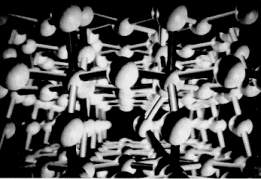 Fig. 9. Molecule, limited-edition hologram (250 copies), 30x40 cm, 1992. An array of spheres connected by tubes representing molecular structure. One of the atoms appear to wiggle when the viewer changes position. |
|
|
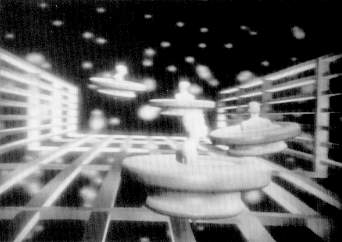 Fig. 10. Flash Tunnel, limited-edition hologram (250 copies), 30x40 cm, 1992. A fence-like tunnel with geometric objects in it. The special effect of this hologram is a light that travels through the tunnel. The reflection of the light on the tunnel creates a flash effect. |
HOUSE OF THE FUTURE
The use of additional frames and the automation of the recording process resulted in an enormous improvement in quality. The result, along with improvements in registration, was a final image that appeared more solid. In 1987, I made a hologram of a computer-generated model of the University of Technology in Eindhoven. When Dutch TV celebrity Chriet Titulaer, host of "Amazing World" (a program about high-tech novelties), saw this hologram in 1988, he immediately wanted one made for his "House of the Future" project, an innovative nationwide collaboration of construction companies. Designed by noted Dutch architect Cees Dam, the visionary house projected the most dynamic current trends in architecture, interiors and appliances. The planned start of the project was coming up quickly, but the foundation of the building had only just been laid. Using our new technique, Titulaer could visualize and present the building.
Just at that time, the university had planned to upgrade the visualization department with a new computer workstation and Wavefront software. They imported all of Titulaer's architectural data into the computer, and we then produced what were probably the first computergenerated embossed holograms, with a run of 40,000. We followed in January 1991 with the first full color computer generated image-plane reflection hologram, made with three different laser lines, allowing color separations of a single image. The hologram looks the same as the image on the computer screen, but appears to be in three dimensions.
LIGHTING SYSTEMS
In 1989, both AKZO Chemicals and Hewlett-Packard commissioned us to design and produce a series of 30x40 cm holograms. Since these holograms were sent worldwide to representatives, we developed a special telescoping halogen light to simplify the display of the holograms. The recipient only needs to unpack the stainless-steel lighting unit from its small box and hang it on a nail on the wall. The hologram frame hangs on the slick lighting unit, ensuring that the reconstruction angle is always correct.
All of this work culminated in an invitation for me to sit on a panel discussing commercial and fine-art holography at the Society for Photo-Instrumentation Engineers (SPIE) conference in Los Angeles in January 1990.
FUTUROSCOPE
In early 1990, our computer-generated work led us to a new assignment. Parc du Futuroscope had been looking for a way to enhance the identity of their futuristic media park in France. A computer-generated embossed hologram of their two most characteristic buildings was made. At the same time, we installed a permanent show of their holograms, now seen by about one million visitors each year.
MASS PRODUCTION IN SILVER HALIDE
In September 1990, we produced 6,000 pieces of 8x10-in film (another 2,500 pieces were produced by Mike Mielke in Munich) for the German advertising agency Lauk Kommunikation for their client Bayer AG, to promote their product “ADALAT”. Total production time was 20 days, including lamination; this turn-around time-speedy for silver-halide mass production-was made possible by our improved proprietary scanning system.
MULTIPLE PHOTO GENERATED HOLOGRAPHY
In January 1991, we recorded our first multiple photo-generated hologram (MPGH). The hologram shows our crew (five people at that time) posing in the freezing cold in front of the lab building. Passers-by were amazed by the scene in front of DHL, with our computer-driven camera snapping picture after picture as it moved along a 10ft long rail. We had just developed a new theory allowing us to record the right sequence of perspectives to produce an undistorted final hologram. The results were published in the proceedings of the March 1991 SPIE conference in the Hague [8].
While testing our new optical registration system in January, we produced the first full-color computer-generated imageplane reflection hologram, using three different laser lines to produce the light primaries of red, green and blue. In February, Philips electronics company came to us looking for assistance on one of their new campaigns. To accompany the slogan "Now let Philips open your eyes," they wanted a 50x60 cm holographic image of a statue of a woman's head, which would turn into an actual woman's face and come to life as the viewer looked across the plate. With our newly developed technique for MPGH, we realized that this ambitious request was possible. In a nearby photo studio, after some lighting tests, we shot the footage for the hologram Diana, which changes from a sculptured bust into a woman who starts to smile at the viewer near the end of the sequence of 220 images.
FULL COLOR REFLECTION MPGH
In June 199 1, Suzanne St. Cyr called us to find out if it would be possible to record a full-color reflection hologram of baseball star Ricky Henderson (Fig. 7).The original film was recorded by Sharon McCormack for American Bank Note Holographics to make holographic baseball cards. Because the subject rotated while the film footage was being shot, we realized that we needed to adapt our stereogram setup for the particular recording geometry of the Henderson footage. An extension of the theory for recording the right perspectives was developed over the weekend to accommodate McCormack's rotational shooting technique (and presented at the Lake Forest SPIE conference in July 1991) [9]. After some experimentation, we found that the new configuration worked and produced a full-color image-plane MPGH of Henderson, made with three laser lines to give a mix of the light primaries.
MPGH IN ACTION
Using our fully automated MPGH system, we produced four holograms for Philips for the World Expo '92 in Seville, Spain. These holograms demonstrated the latest possibilities of holography. The images included a woman driving in her car, a hand-held telephone, a laptop computer and a fax machine with paper coming through it, slowly revealing the text: "Communications talk with Philips".
The experience gained with this project convinced us it was now possible to record on location. To prove this, 2 months later we shot an MPGH hologram for Citibank Germany at one of their banks in Cologne. The hologram shows a woman putting her bank card into the machine and then operating the banking center machine. This is another example of the possibilities of holograms, showing the capability of producing 3D animation instruction films of real, live scenes.
In April 1993, artist Dieter Jung approached us with an ambitious project for the European Patent Office in Munich. A total of 18 square meters of holograms were produced and applied to a 2x3 m sign with thin, 3-sided, rotating vertical panels. Different holograms were applied to each side. The holograms were all unique in design. To promote and support this project, we produced a full color computer generated embossed hologram.
HOLOPRINTERS
After the recording of many holograms with MPGH technology, holography came out of the darkroom. This made my life as a holographer even more interesting. Now we record the subject on location, in the photo studio or at the computer (Fig. 8). With Eric van Nuland, who is employed as a researcher at DHL, I worked to expand our knowledge and develop Holoprinters.
Our Holoprinter work created interest. In October 1991, Urs Fries of the Kunsthochschule für Medien of Cologne, Germany, asked us to build one of our printers for the school. In March 1992, we delivered the first two-step Holoprinter to the Kunsthochschule für Medien in Cologne (see Fig. 8). To control the Holoprinter, we developed software that is totally mouse driven and runs on a 386 IBM-PC under Windows 3.1. The input for the Holoprinter is 35mm color-slide film, and the output is a laser transmission master hologram. After we installed the Holoprinter in Cologne, we held a photographic shooting session on site. A special Nikon F camera that moves automatically on a track recorded 150 slides of Dieter Jung posing. After we developed the footage, we transferred it to a hologram with the Holoprinter.
With the Holoprinter, a new era of reflection holograms began. Our ongoing research [10-12] is directed toward automation of the holographic process, so we began looking for an electronic interface between the computer data and the Holoprinter. The 35mm slide film for the Holoprinter produces high-quality holograms, but the new liquid-crystal display (LCD) technology being developed at Philips in Eindhoven suggested itself as a possible electronic interface. The Philips LCD group was interested in our work and willing to loan us a state-of-the-art active matrix black-and-white LCD screen. After the board had approved the cooperation, I was happily surprised to find that several of my student friends were working on the development of this new screen, giving us friendly support. Because of its limited size, it would not be suitable for large reflection holograms, but would be ideal for photoresist mastering.
DIGITAL HOLOPRINTER
Another major hardware development for us was the design of the Digital Holoprinter for the production of full color embossing masters. The Digital Holoprinter is similar to a regular Holoprinter with LCD technology as the interface device, which allows for a direct connection between the Holoprinter and the computer. Images designed in the 3D Holosoftware TRACES can be automatically transferred into photoresist masters from which the embossed holographic material, e.g. stickers, are produced. The photoresist records the graphic computer data from an LCD screen. This is done under an achromatic angle, thus producing fullcolor holograms. With this new LCD technique, pixels are invisible, comparable to 35-mm slide film quality.
DOTPRINTER
Our third major hardware development was the Dotprinter. European Optical Disc commissioned us to prepare holograms for compact disc (CD) masters. We made several commercial designs using our Dotprinter technique. The Dotprinter produces dotsized holograms in rainbow colors; both the reconstruction angle and the color can be controlled. Production cycle time for one dot is 0.7 sec if shot in photoresist. During this cycle time, both angles are adjusted, the x, y position of the hologram is advanced, the system is allowed to settle to minimize vibrations and the exposure is made. The Dotprinter converts pictures made in a drawing program to spectacular dynamic holographic colors that-from the ideal viewing angle-are identical to the design made in the computer. This technology can be easily adapted to CD production, packaging and paper embossing.
3D HOLOSOFTWARE TRACES
|
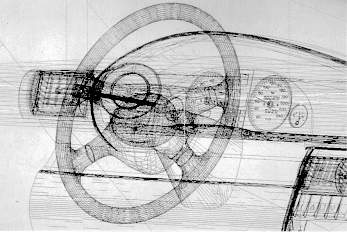 (a) (b)
|
PBTS
In July, we entered a subsidizing competition (called PBTS) of the Dutch Ministry of Economic Affairs and were awarded funding for the onestep Office Holoprinter Project. Part of the purpose of the Office Holoprinter Project is to research the possibility of turning digital video into 3D holographic images. To achieve this, we invested in a new Silicon Graphics R4000-based video framegrabbing system (64 bit, 80Mb RAM, 3Gb storage) with a high resolution CCD camera.
FUTURE DEVELOPMENTS
In March of 1993 we displayed our Office Holoprinter with three new holographic machines at Cebit '93 in Hannover, Germany. (Cebit is the largest annual European computer show.) This office Holoprinter, when hooked up to a Silicon Graphics 3D workstation, can print a computer generated design in three dimensions. The office Holoprinter will use a high resolution LCD screen as the interface between the computer and the final hologram. The development process could be similar to ordinary copiers, using a dry process with DuPont's new polymer, requiring only ultraviolet light and heat to enhance the development of the image. Many people at Cebit showed interest in our Office Holoprinter applications. As a result, we are now doing benchmark tests for two major international companies.
In the past 2 years (1992-1994) we have proved the feasibility of the printer concept and have made many excellent holograms. In September 1994 we entered into the second phase in the Ministry of Economic Affairs' BSI program contest, and we recently have been awarded with a Phase II subsidy. In July 1995, DHL will expand its premises with a recently acquired building of 1200 m² (1100 ft²). The building is located on the other side of the canal from our original headquarters.
All these developments will bring holography to the desktop and therefore into the mainstream. Designers and engineers in industrial, architectural and packaging firms can routinely use 3D visualization techniques frequently and easily. Dimensional prototyping can be readily communicated, analyzed, modified and printed again from the computer workstation. By adapting the office Holoprinter, graphic designers without any knowledge of holography can make photoresist masters. These can be converted by a printer into embossed holograms for incorporation into a final printed piece. Like a fax machine, computer or photocopier, the Desktop Holoprinter will be a "black box user tool": nobody will need to know exactly how it works but everybody will know how to work with it.
We expect that the combination of our interests in developing holography, lighting systems, packaging, industrial applications and computer-generated holography will widen the field and provide us with many interesting challenges to come. Bringing holography into the hands of the public through links with the world of computers offers as yet unimagined possibilities for creativity. I look forward to many years of developing the tools of the future.
ACKNOWLEDGMENTS
Over the years, many people have shown great dedication to DHL. Some have moved on to pursue careers in their own disciplines. In the early days, there were Toine van Dorst, Rob Hoogeveen, Yvonne de Goey, Pierre Lanen and Erwin Käller; in the middle years, there were Renate van Oorschot and Willemien Damen; and Eric van Nuland, Walter Bliek, Jolanda Dekens, Geert-Jan Plattel, Niels Govers, Wim Mandemakers and Eugène Rath make up our current staff. Many thesis students from both the Institute of Higher Professional Education (Physics department) and Eindhoven University of Technology (Architecture, Electronics and Computer Science departments) have worked on DHL's developments. Thanks to their commitment, DHL's ongoing research, development and application of innovative holographic techniques will continue.
References and Notes
1. R. L. Lamberts and C. N. Kurtz, "Bleached Holograms with Reduced Flare Light,"J Opt. Soc. Am. 60 (1970) p. 724A.
2. W. Spierings, "Pyrochrome Processing Yields Color Controlled Results with Silver-Halide Materials," Holosphere 10 No. 7/8, 1-7 (1981).
3. W. Spierings, "Practical Considerations on Solution Physical Development," Proc. Intl. Symp. on Display Holography Vol. 2, T.H. Jeong, ed. (Lake Forest College, IL, 1986) pp. 299-302.
4. T. Cvetkovich, A. Eijnde and W. Spierings, "Hypersensitization," L.A.S.E.R. News 3, No. 1, 5-6 (1986).
5. W. Spierings, "Photoresist Technology for Holographic Applications," Proc. Intl. Symp. on Display Holography [3] pp. 523-535.
6. M. C. King, A. M. Noll and D. H. Berry, "A New Approach to Computer-Generated Holography," Appl. Optics 9 (1969) pp. 471-475. See also DJ. de Bitetto, "Holographic Panoramic Stereograms Synthesized from White Light Recordings”, Appl. Optics 8 (1969) pp. 1740-1741.
7. Steve Benton presented the first computer-generated holograms at the Lake Forest conference in 1985 and convinced me that this was the way to go.
8. W. Spierings and E. van Nuland, "Calculating the Right Perspectives for Computer Generated Holograms," Proc. SPIE (1991) pp. 1600-1649.
9. See Spierings and van Nuland [8].
10. W. Spierings and E. van Nuland, "Development of an Office Holoprinter," Proc. SPIE [8].
11. W. Spierings and E. van Nuland, "Development of an Office Holoprinter II”, Proc. SPIE (1992) pp. 1667-1706.
12. W. Spierings and E. van Nuland, "Development of an Office Holoprinter III," Proc. SPIE (1993) pp. 1914-2002.
Glossary
single-beam reflection hologram-a hologram made with a single beam, viewable in white light in one step. The reference beam light travels through the film to illuminate the object. This classic technique was invented by Yuri Denisyuk in 1963.
laser-transmission master hologram-a hologram viewable in laser light that produces a real image that, in turn, becomes the object for a transfer hologram.
image-plane reflection hologram-a hologram with imagery coming forward through the film plane. It is viewable in white light and is made using a laser transmission master as object, with the reference beam coming from the opposite side of the plate.
broadband development-a chemical processing scheme that takes advantage of a wide part of the spectrum of light to reconstruct the hologram.
Russian regime of colloidal development-a processing method that overdevelops the silver in clump formations by migration within the holographic emulsion. First explored by Soviet scientists, this technique offers bright results and subtle colors.
argon laser-a large laser that emits light in several lines in the blue and green part of the spectrum.
photoresist-a recording material for making masters for embossed holograms. Photoresist plates capture the interference pattern in relief so the surface can be metallized for plate-making.
© 1995 1SAST
LEONARDO, Vol. 28, No. 4, pp. 273-280,1995
Walter Spierings (holographer), Dutch Holographic Laboratory B.V., Kanaaldijk Noord 61, 5642JA Eindhoven, the Netherlands.
Ana Barreto (biographer), 445 Grand Street, Brooklyn, NY 11211.
Received 17 December 1991.
| Back to articles |
© Dutch Holographic Laboratory


